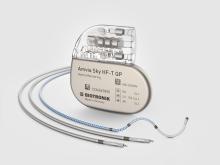Results from the MATRIX study show that the high detection accuracy of DX single-lead ICD systems for atrial fibrillation (AF) episodes (99.7% for ≥ 1h episodes) in combination with the strong transmission performance of BIOTRONIK Home Monitoring® allows for reliable guideline-recommended remote monitoring of subclinical AF. The findings were published in Europace earlier this week.1MATRIX evaluated the utility of the DX-ICD system (atrial signal detection via a floating dipole integrated in the ICD lead) for remotely monitoring atrial high-rate episodes (AHRE) and their duration progression. In addition, the study analyzed the clinical implications of AHRE detection and progression. The outcome of the study should be interpreted in the context of the 2020 European Society of Cardiology’s guidelines on AF which recommend remote monitoring of device-detected AHRE and provide further guidance depending on the AF burden along pre-specified duration strata.The study was led by Prof. Dr. Gerhard Hindricks, De
Prof. Michael Haude, BIOMAG-I Coordinating Clinical Investigator, presented the latest results of the BIOMAG-I clinical study at the Cardiovascular Research Technologies (CRT) meeting.1 At six months the angiographic and clinical data showed a low in-scaffold late lumen loss (LLL) rate and a good safety profile with no scaffold thrombosis. A low proportion of mal-apposed struts after implantation was observed, at six months struts were no longer discernable. The intravascular imaging documented a preservation of the scaffold area with a low mean neointimal area. Bioresorbable scaffolds have been developed to provide temporary mechanical support, while controlling neointimal proliferation over the vascular healing period and preventing long-term stent-related adverse events. DREAMS 3G, BIOTRONIK’s next generation drug-eluting resorbable Magnesium scaffold (RMS), is made of a proprietary Magnesium alloy and maintains a resorption time of 12 months. Compared to its predecessor DREAMS 2G, it offers unique be
In the first-in-human study BIOMAG-I, BIOTRONIK’s new-generation DREAMS 3G resorbable magnesium scaffold (RMS) showed significantly lower in-scaffold late lumen loss (LLL) than its predecessor at 12 months as well as excellent safety and efficacy. Prof. Michael Haude, BIOMAG-I Coordinating Clinical Investigator, presented the latest results in the late breaking trial session at the EuroPCR course.1 At one-year follow-up, BIOMAG-I data confirmed the excellent safety profile of DREAMS 3G RMS with a low target lesion failure rate of 2.6%. Neither cardiac death and myocardial infarction occurred, nor scaffold thrombosis was reported. After completion of the resorption, the in-scaffold LLL was 0.24±0.36 mm, comparable to contemporary drug-eluting stents (DES).2 “At the end of the scaffold resorption, at 12 months the data showed, that the DREAMS 3G scaffold has an excellent safety and efficacy profile”, said Prof Michael Haude, Rheinland Klinikum, Germany. “The late lumen loss is not just 38% better
BIOTRONIK announced today the opening of its new Asia Pacific Manufacturing and Research Hub. The 20,000 m² site will serve as the company’s central hub in Asia-Pacific, with hundreds of employees working in manufacturing, quality, research & development (R&D), and sales and marketing. BIOTRONIK, founded in Berlin, Germany, in 1963 is a pioneer in implantable pacemakers, defibrillators, and vascular intervention for 60 years. BIOTRONIK’s presence in Singapore began in 2012, and in 2016, the company inaugurated its first manufacturing site, complementing its high-quality manufacturing sites in Germany, Switzerland and the United States. Now in 2023, the new facility has been designed with an emphasis on workspace agility for modern, optimized collaboration. The new site includes several spacious cleanrooms and laboratories developing and manufacturing state-of-the art Cardiac Rhythm Management (CRM) devices. “We are excited to be the first major manufacturer in the cardiac rhythm mana
Material compliance is concerned with environmental and international laws and regulations that restrict or even prohibit the use of various substances in products.The monitoring of substances of very high concern (SVHC candidates) is regulated by the REACH regulation. We are closely watching the development of the candidate list established according to article 59.If a product contains SVHC candidates of at least 0.1% downstream users must be notified (Article 33 (1)).The following product information sheets depict our current state of knowledge. If there is no product information sheet available, the product does not contain SVHC candidates to the best of our knowledge.
BIOTRONIK, a leading global medical technology company specializing in innovative cardiovascular and endovascular solutions, proudly announces a multinational distribution partnership with Texray, the pioneering developer of a groundbreaking radiation protection textile. In this collaboration BIOTRONIK will distribute Texray's head and neck protectors starting in selected European and Middle Eastern countries. Both partners aim to raise awareness about the critical importance of radiation protection for healthcare professionals, who serve in environments where radiation exposure is an inherent occupational risk. “Texray's radiation protective textiles complement BIOTRONIK’s product portfolio, enhancing our ability to offer customers comprehensive protection solutions. We are delighted to expand our offering, ensuring that healthcare professionals have a range of radiation protection options to support their safety in their daily work,” says John Brumfield, Global Vice President Marketing CRM at BIOTR
Cardiac catheterization labs can be complicated workplaces when it comes to occupational safety.
Coronary drug-eluting stent (DES) systems are stents which are pre-mounted on a balloon catheter. DES are used for the treatment of coronary arteries and release an anti-proliferative drug to the vessel wall.
